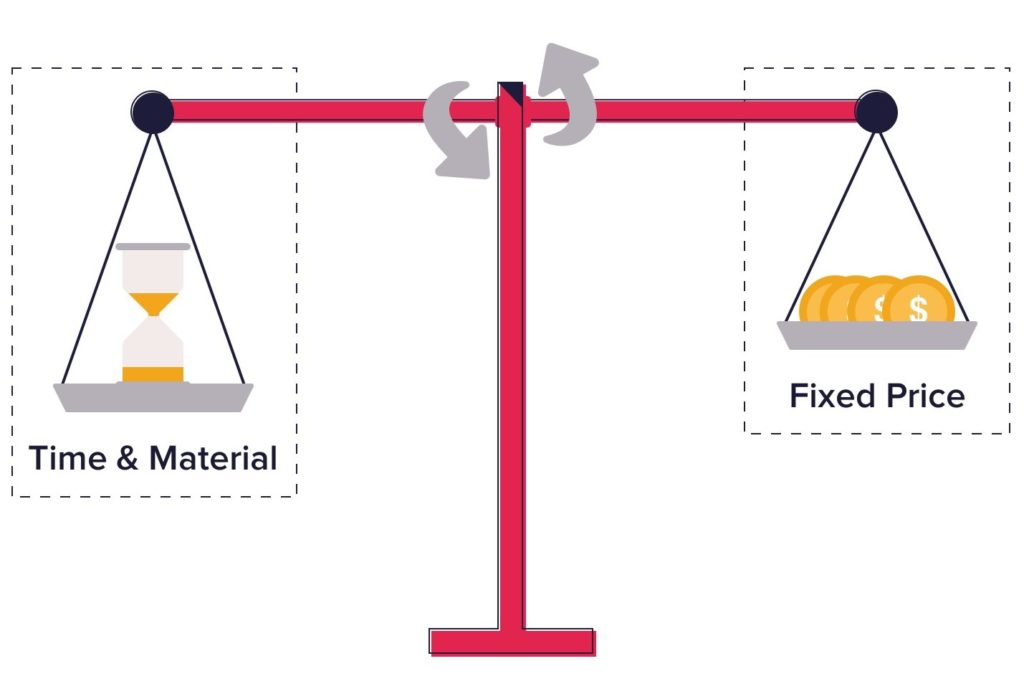You’ve finally settled on the right software developer and it’s time to set up a contract. You don’t want a pricing model that will force you to renegotiate late, so you want to get it right the first time.
Let’s break down two popular software project pricing models to help you make an informed decision.
Let’s start by defining these terms:
Time and Materials Contract: This is where you pay for labor and expertise on an hourly basis. You take care of their time and the cost of the materials they use to get the job done.
Customers are charged for the amount of hours spent on a specific project, plus costs of materials. The main advantage of T&M model is flexibility and opportunity to adjust requirements, shift directions, replace features, and involve users to get the very product.
Fixed Price Contract:
The fixed-price agreement is a single-sum contract (lump-sum) where a service provider is accountable for completing the project within the agreed sum set out in the bond. It can be an effective choice in those cases when requirements, specifications, and rates are highly predictable, elsewise the cost will be anything but constant. A client should be able to share his clear vision of the product with developers to ensure appropriate final results.
Here, you agree on a specific rate that you’ll pay for the entire process. You’re therefore to only pay that set rate, regardless of the time and resources it took to get the job done.
Many people are used to the fixed price model. It’s simply a set-and-forget model where you agree on a price and expect the job to be delivered. It may work for other services where the outcome is specific and predictable. You can easily budget for it.
However, the software development field is different. You may need quick changes to the software, which may differ from what you’d agreed on the fixed contract. That’s why today’s entrepreneurs are considering the time and materials (T&M) model.
When to use a fixed price contract:
- Clear requirements and determined deadlines;
- Limited or fixed budget;
- MVPs;
- Small projects with the limited project scope.
Pros of Fixed Price Software Development Contracts
1. You work with a specific budget
As the name suggests, the price here is fixed. You just need to set aside a certain amount for the job and give specific instructions. If you’ve decided to spend a certain amount in 3 months, you can budget for that and confidently use your other finances on other areas of your business.
2. It’s predictable
Assuming everything goes well, you can know what to expect in regards to financial costs. You simply give specifications, a deadline, and an amount. After that, you wait for the product to be delivered.
3. Minimal project management requirements
Everything is defined in the contract. Therefore, you spend little to no time managing the fixed price project. You just wait until it’s done so that you can check to see if it was delivered according to your specifications.
Cons of Fixed Price Contracts
1. It’s too rigid
The software market is dynamic. You can’t always assume that everything will work out in a specific way. In fact, you may not know the exact needs of your users yet. A lot can change in 3-4 months. Some of these changes may force you to add features that were not included in the initial contract.
This will then require fresh negotiations, negating the set-and-go arrangement you expected and increasing the budget and time required to get the job done. If negotiations and paperwork take too long, your project can be delayed significantly.
2. Preparation and execution can take a long time
With a fixed price contract, you have a fixed scope, fixed budget and fixed time.
You’ll need to take a long time studying the market and predicting what may work for your users. This may require a few sittings with your team, the development team and probably a few consultants. The contract needs to be thoroughly detailed so that the developers do not get out of scope.
Additionally, the developer needs to be okay with your budget and scope. In case they’re not okay with it, you may need to get back to the table again.
3. There are significant risks involved
Even the best laid plans can fail. It doesn’t matter how meticulous your plan is. Something crucial may change. And this can mess up everything, forcing you back to the drawing board.
There are many risk factors here. Things like communication challenges, changes in the software environment, new studies, legal requirements and market changes can give you a headache.
And remember that you will have to pay for each new change that was not covered in the contract.
When to use T&M price contract:
- Long-term projects with dynamic requirements;
- Project scope is not yet fully known;
- You want the flexibility to modify the scope or vary the workloads.
Advantages of Time and Materials Contracts
1. Ultimate flexibility
This model is very flexible. Generally, you won’t come across issues when making changes, since you’re only paying for the work that’s actually been done according to your hourly rates.
You can easily modify the scope of work, request for addition or removal of features, and use flexible (agile) software development methodologies.
2. Maximize the value of time
You don’t have to spend too much time drafting specifications. You can start with the idea and keep developing it with the team overtime. This helps you to deliver the MVP to users faster and get feedback on its value.
The quick feedback can promptly inform you on further iterations that are needed. With such a cycle, you end up designing what you actually need. It helps you not to overdesign or overpay your developer for things that don’t work with your users.
4. Get better value for money
You’re in business, so you want to make sure that every dime you spend brings in value, right? The time and materials contract will help you test things faster with users. You can then focus on features that bring in the highest returns to your business.
You spend less time and resources on getting the paperwork done right before starting. There is less chance of miscommunication about a feature. Since you get frequent updates, you can fix mistakes quickly. This saves you precious time that you can use to take care of your core business.

You can verify the time logged by the developer so that you’re not overcharged. And as you keep testing and optimizing useful features, you may end up spending less money than a developer would have quoted for a fixed price agreement.
Disadvantages of Time and Materials Pricing Models
1. Your budget is not specific
This can be good if you end up going below your expected budget. However, should it take longer to implement some features, you may end up spending more than you had planned.
2. Heavy involvement
You will need to stay involved with the process. To optimize performance, you may need to use project management and time tracking software. You’ll have to keep making decisions as you test every iteration. You therefore have to be ready for involvement in your project.
The Verdict: Which Pricing Contract is Better?
So, what should you choose for your software project?
It may be so tempting to go for the fixed price model. It looks like it will save you a few bucks. You’ll have a specific deadline and scope of work. However, you can never ignore the fact that software projects change quickly, and a significant change can cause a disaster.
A time and materials contract makes more sense in software development work. Here, you get the ultimate flexibility and speed that you really need. You can get started with a project right away and keep testing and optimizing it. You can focus your energy on what works best. You’re not just waiting on a deadline (that may need to be extended anyway).
Question:
You are negotiating with a contractor for additional staff augmentation - a number of software developers and a few testers. As a buyer you dont quite have the exact statement of work ready. What kind of contract is MOST appropriate for this kind of work ?
A. Time and Materials - T&M
B. Cost plus fixed fee – CPFF
C. Firm Fixed Price Contract - FFP
D. Fixed Price Incentive Fee Contracts - FPIF
A is the correct answer.
As the nature of work is not quite clear and this deals with contracting additional staff - the best choice of contract is T and M. Fixed price contracts are applicable where scope of work is quite clear which is not the case here. Here choosing a Cost-reimbursable contract makes no sense - since the unit rate of staff can be determined and agreed between you and the seller - so the best option is A (T&M).
Via baytech consulting






